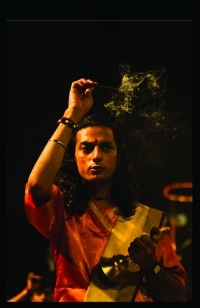.jpg)
Smoking Ganja on the Ganges
Marijuana has been a part of the culture in India for thousands of years. It is not uncommon to see sadhus fixing a chillum (a conical clay pipe) full of cannabis or hash and tobacco.
“Respect all religions. Practice your own.”
So said a Swami visiting Australia many years ago in interview when asked if he wished to attract people to his Hindu faith. Proselytisation is an alien concept in Indian religions such as Hinduism, Buddhism, Jainism and Sikhism.
Sectarianism violence has played – and still plays – a central role in the politics of the Indian subcontinent, as it does in the rest of the world. But, my experience on the ground has always been of people for whom religious expression is an integral part of their daily lives, and who are happy to share their rituals with me – and even give me blessings – without any expectation that I believe as they do.
This was certainly the case ten years ago when I was in the most holy Hindu city of Haridwar in Uttarakhand, North India, with photographers Gavin Gough and Matt Brandon to experience the Kumbh Mela.
I’ve written about the Kumbh Mela before (see: Faces in the Crowd; Crowds on the Move; and Colours in the Crowd). Considered the world’s largest congregation of religious pilgrims, the festival takes place every three years at one of four sacred river sites. Hindu faithful come from all over India, carrying their kumbhs (water pots) or other containers to transport water from the sacred rivers home with them. The festival plays a central spiritual role in the country and is inscribed on UNESCO’s Representative List of Intangible Cultural Heritage of Humanity.
A large proportion of the more than 10 million people who arrived in the ancient city of Haridwar to take part in the gathering were sadhus – those wandering ascetics seen all across India and the neighbouring countries. These men fascinate me: although the colour of their robes and the design of their tilaka (forehead markings) are meant to show which sect they belong to, I never saw two who looked the same! Indeed, researching the literature only reinforced my confusion about their many different traditions, customs, practices, and beliefs. According to one site (Facts and Details), there are around five million sadhus in the country, belonging to several thousand schools or sects.
On more than one occasion on that long-ago trip, I was offered a share of pipe by one of the sadhus. In most Indian states, possession of marijuana or hashish is a criminal act, and secular people caught indulging can be subject to harsh penalties. But sadhus – many of whom sit in a smoke haze all day – seem to be exempt.
Even more commonly (and possibly just as high-risk for a foreigner!), I was invited to share food that women were making at their camp sites. I’m always moved by how generous people can be with strangers – even when they seem to have so little themselves. I acceded to some of these offers and the food was always wonderful. Fortunately, I suffered no ill effects.
Come with me to the portable campsite in Haridwar and meet a few of the colourful Kumbh Mela pilgrims.
.jpg)
Corral
The Bairaagi Campsite outside central Haridwar has an interesting crowd management system.
.jpg)
Sadhu with Japamala
Garlands of prayer beads – usually 108 – are commonly used to keep count while reciting prayers or mantras.

“Namaste!”
So many of the visiting holy men are quick to greet me.

Smiling Sadhus
This was the eve of the holiest day of the kumbh mela: everyone was in a good mood.

Tin Cup
The famous Naga sadhus, who are totally naked except for the ash they smear their bodies, were in a remote area of the camp, and I didn’t go looking for them. But, even in the central areas, there were some unique forms of dress.

Rapture
This joyful sadhu with his beads, bells, and bone stick, was my favourite; …

Dancing Sadhu
… he certainly lived up to the exhortation to dance like nobody is watching.

Reading Prayers
Religious study, and philosophical discussion and debate, are a large part of the purpose behind the gathering.

Young Man at the Mela

Guru on a Stage
Every colourful tent houses its own sect, and every sect has its own gurus, acolytes, and devotees.

Mixing Tilaka
Outside the tents, groups of men are clustered, …

Applying Tilaka
… helping each other get ready for the day.

Mixing Colours
Tilaka is generally made by mixing freshly ground sandalwood, vermilion, turmeric, or ash with lime or water. The actual composition is prescribed by one’s purpose and religious sect.

Applying Tilaka
Tilaka is generally applied with the ring finger to the forehead …

Sadhu Getting Painted
… and on the arms, chest, neck, and back: all while reciting prayers or mantras.

Under a Sacred Fig
Bodhi trees (ficus religiosa) are found all over Southeast Asia. Sacred in Hinduism and Buddhism, they provide local medicines – and shelter from the heat.

Lighting a Chillum

Concentration

Hindu Man

Many Hands
Like an army, a religious festival marches on its stomach. But, making food for the masses is no chore when friends work together.

Cooking Panipuri
In one popular street food, semolina pockets are stuffed with cooked potato, onion, and chutney. This version was cooked over a fire fuelled by dried dung.

Watching the Fire
The women keep careful watch over the cooking food.

Hands making Food
The balls come out of the fire too hot to handle!

Panipuri and Chilli

Bags of Herbs
The women have brought their ingredients with them.

Cooked Tomatoes
Freshly cooked tomatoes are peeled, before the herbs and spices are added to make a tangy sauce. The end result was wonderfully tasty!

Sadhu in a Niche
There is a charismatic holy man in every nook and cranny –

Woman in Purple
– and smiles are all around.
The mood over the whole festival grounds was euphoric.

Of course, part of that could have been the cannabis smoke wafting through the air.
Namaste!
Photos: 13April2010


































.jpg)


[…] (Allahabad), Trimbak (Nashik), and Ujjain. It is a major pilgrimage festival in Hinduism (e.g.: Sadhus, Smoke and Street Food) that includes rituals, religious discussions, devotional singing, and traditional ceremonies. One […]